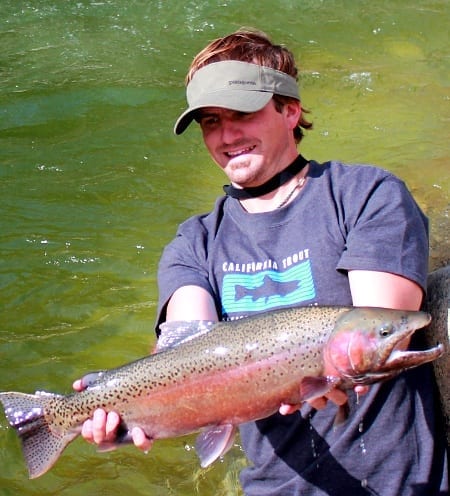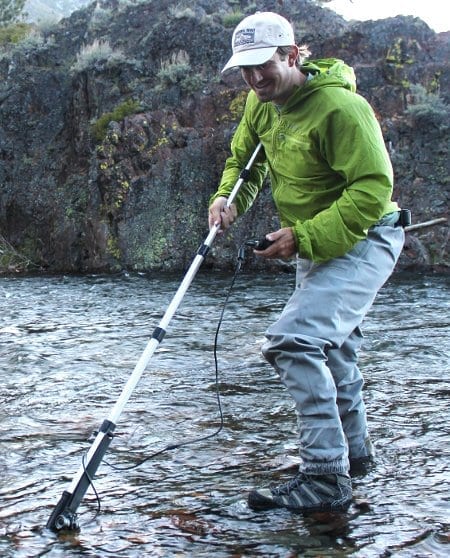CalTrout Interviews (And Hires) Michael E. Wier
The CalTrout Interview: Michael E. Wier
Mike Wier has joined CalTrout, and the well-known fly fishing videographer will put his considerable talents to work helping protect and restore California’s fisheries.
Wier is a Patagonia fly fishing ambassador and the owner of Burl Productions, his video production business.
He’s lived and fished in California almost his whole life, and we’re excited to have him on our side.
[youtube]http://youtu.be/6QAhwcLQD3E[/youtube]
Q: How long have you lived and fished in California, how does it compare to the rest of the world?
A: I’ve lived in California almost my entire life. My parents moved back to California from New Zealand when I was two. I started fishing when I was four and fly-fishing by 7 or 8. I’ve been very fortunate to have the opportunity to fish in some really amazing lakes, rivers and oceans around this planet.
People ask me all the time “Now that you’ve been all around the world, where’s your favorite place to fish?” Without hesitation I always say California. California has so many diverse fishing opportunities.
We’ve got more unique species of native trout and salmon than any other state in the lower 48. They live in a huge variety of habitats from small streams in southern California to the coastal rivers and Redwood forest up north and everything in-between. Spring creeks, free stone rivers, tail waters, coastal lagoons, spring fed lakes, high country lakes, reservoirs and the list goes on.

OK, we know he can catch fish...
Then you add in all the warm water fishing for black bass, small mouth bass, rock bass, striper, carp, catfish, perch, crappie, squaw fish, shad and again the list just keep going on and on.
Throw in the ocean fishing opportunities and you really enjoy a cornucopia of fishing. Best part is that all these possibilities are pretty close and most good areas to fish are free and open to the public. California also produces big fish! Lots of records come out of our state.
Q: You’ve fished all over California: where are your favorite places to fish?
A: I really enjoy a multitude of different fishing venues around the state. I like fishing top water for Black bass in foothills lakes, ponds and the Delta. I enjoy fishing for Stripers in the Central valley rivers and Delta. I really dig coastal steelhead fishing, especially in the Smith and Klamath drainages.
But I guess the places closest to my heart are the cold high country streams and lakes of the central Sierra Nevada Mountains. I love all the west slope rivers where I grew up, like the Mokelumne, American, Toulumne, Stanislaus, Calaveras, Yuba, Merced and Consumnes.
They each have their own character as well as epic swimming holes. I still have a special love for the Tahoe area. I have spent most of my guiding career on the East and West Carson Rivers, Big and Little Truckee and East Walker River. Those rivers will always be special to me.
Q: Tell us about the equipment you use to make videos.
A: My arsenal of video equipment is always expanding and changing. Right now I have a Cannon 7D and a Cannon T2i that are getting the job done pretty well. They are both very diverse tools that offer the most flexibility for creating pro media on a budget. I can shoot stills and video with one compact unit.
I still have a Sony HDV camcorder for the times I start missing that zoom button and auto adjusting focus. I also have a sweet new underwater filming rig with a POV cam attached through a cable to a screen so I can see what I’m filming underwater. And of course I do have a GoPro2 that’s usually in the bag for back up shots and places I don’t want to pull out the big cameras.

Mikey doing his Underwater Video Man impression
Q: What two tips would you give people to help them make better videos?
A: First and most important: Get a good tripod, preferably with a fluid head for pano shots. No one wants to watch a video where every shot is hand held and it looks like it was filmed during an earthquake. Second, don’t get too hung up on the gear. Get a good camera that works well and learn to use it well.
Image quality is important, what’s more important is your content and story telling. Don’t break the bank on gear when you are just getting started. Get something decent for a decent price that will get the job done and then build up from there. Unless money is no hang up, in which case you might as well get the goods.
Q: What conservation causes are you passionate about, and what do you think are the biggest problems facing California’s Fisherman.
A: Wow, that’s a big one. Where do I start? I guess I’ve always been a proponent of native and wild fish. I’d like to see our native trout and salmon species thrive in their historic waters well into the future and preferably without the assist of hatchery programs. I think with a bit of effort from multiple agencies this is a very achievable goal for the state. That would be a great place to start.
We’ve already let one of our native species — the McCloud Bull Trout — go extinct, and we killed off the original Tahoe/Pyramid Lake strain of Lahontan Cutthroat trout that were probably the biggest trout in the world.
We can’t let that happen again, especially to species so iconic as a California’s chinook and coho salmon or coastal steelhead.
I feel these goals can be met while at the same time preserving, restoring and improving recreational and commercial opportunities for fisherman and ensuring there will always be waters open to the public to fish.





6 Comments
Sounds like you made a good choice. Michael E. Wier’s fishing preferences & priorities are the same as mine. Well done on both of your accounts!
Thanks, KC
I’m a 57-yr. old member, fly fishing since I was 8 and tying flies since I was 11, and I’m pretty “old school”. I grew up reading Trout by Ray Bergman and anxiously anticipating the arrival of the inch-thick, orange-and-yellow Herter’s catalog (my dream book) every spring. My first and still “favorite fly” is a gray hackle/yellow, though I tie it now with a variety of gamebird soft hackle instead of the grizzly that existed in the ’60’s. I totally support CalTrout’s hiring of Mikey. His videos express a sensitivity to the resource that is obvious as is his true joy of- and appreciation for- the sport. He is a classy young man who I hope is an example of the new generation of fly fishers. Congrats Mikey and CalTrout!
Mark I still have one of those old Herters catalogs, and I spent hours studying everything I could find by Bergman; his color plates of flies were startling. Only Herters had the ‘right’ flouresent orange yarn for glo bugs (egg fly) and the world was a better place for having folks like Bergman, A. J. McClane and Jack O’Connor in it. I’ve got a few years on you, so I’ll say my favorite fly back then, was the brown hackle peacock, with a fuchsia colored duck quill tail.
Herter’s, Ray Bergman, A.J. McClane, Curt Gowdy, Gadabout Gaddis … love the brown hackle – great wet fly … that and the gray hackle/peacock round out my 3 favorite wet flies, to this day … now I use hen or gamebird whenever possible for the great majority of my wet flies … if you haven’t ever read it and appreciate really well-written fly fishing/fishing-themed short stories, check out “The Last Pool: Upstream and Downstream Big Stony”(circa +/- 1969)(includes When All The World Was Young, and Return Of The Poacher, two great short stories) … I’ve still got one of the Herter’s catalogs too, from 1970 I think … fun to thumb through and check out the fishing stuff as well as the color plates of the gunstocks and bows, and the hunting sections that had photos of Jacques Herter posing with every exotic game animal short of monkeys and orcas!
Definitely some great videos and a great hire. Just a comment about the original Lake Tahoe / Pyramid Lake strain of Lahontan Cutthroat trout. They were *ALMOST* killed off. The U.S Fish and Wildlife Service has been working on a brood population since the 90’s that genetically matches museum specimens (often called the “pilot peak” strain). They have recently started giving eggs to the Mocassin Creek hatchery so that CDFG can start raising them as well. This strain has been doing great in Pyramid Lake, with several fish over 12 pounds caught this past year, and one that tipped the scale 19.5 pounds. Although the challenges are numerous, there is still a possiblity that we may see large native trout in Tahoe once again. I for one can’t wait to catch and release a 10 lb + spawning run Lahontan in downtown Reno!
I am glad to hear that Mike is on board with Cal Trout! He is a great fishing guide and an important advocate for the conservation of our fisheries and waters. His videos from Burl Productions are some of my favorite and I can’t wait to see what Mike and Cal Trout put together!